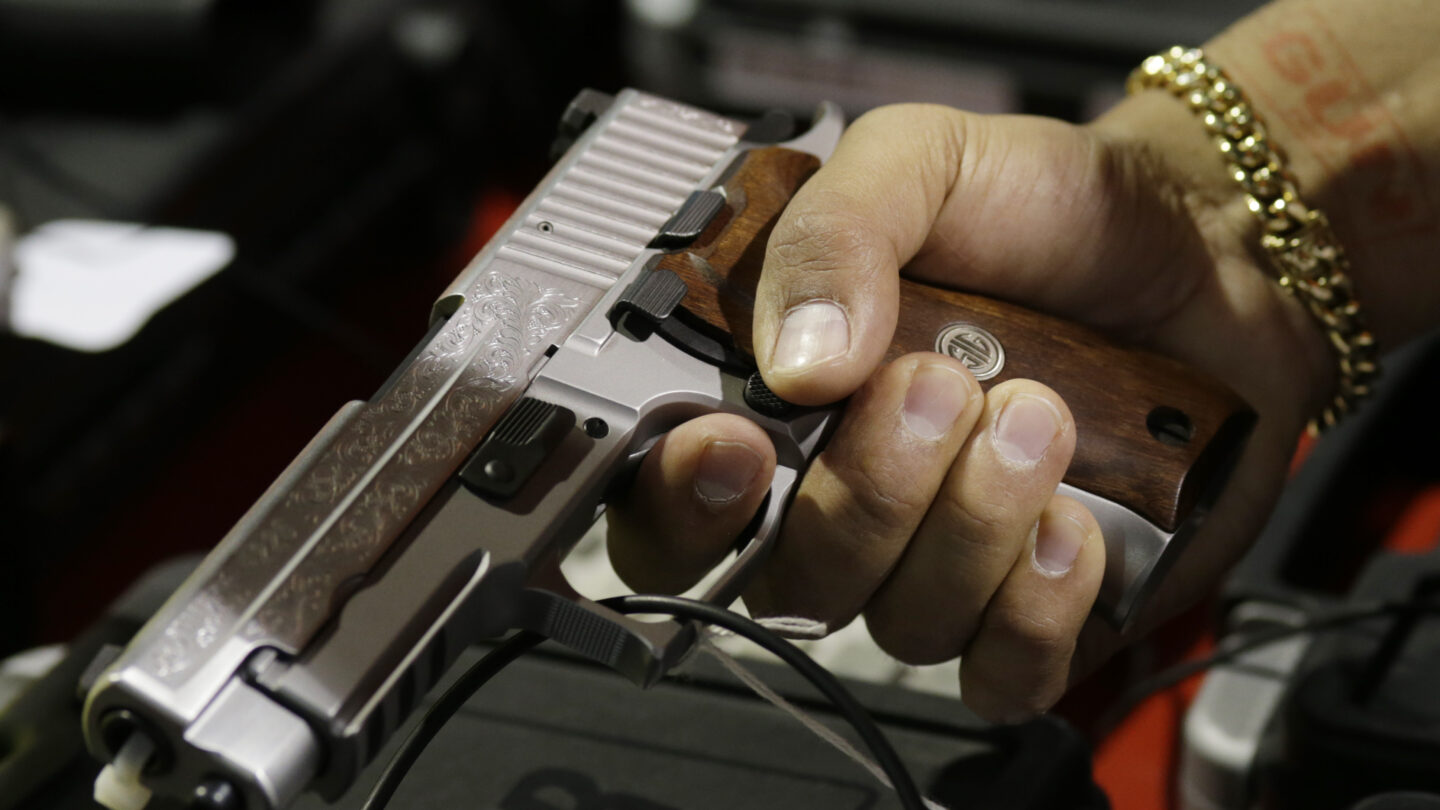Stolen guns, untraceable weapons and other deadly devices are becoming more prevalent in U.S. gun crimes, new federal data shows.
Last week, the Bureau of Alcohol, Tobacco, Firearms and Explosives released an expansive federal report on guns used in crimes in two decades, providing the public with more detail about stolen firearms and gun trafficking.
The data stretches from 2017 and 2021. During that period, local police reported a shrinking turnaround time for a legally purchased gun to be used in a crime. It also provides insight into the spike in ghost guns and conversion devices.ATF Director Steven M. Dettelbach wrote that the findings offer “strategic intelligence” for policymakers, law enforcement and researchers to reduce gun violence.
Gun policy experts have said that the release of this data is a big step in better understanding gun crime in the U.S., and can better educate policymakers on the need to regulate several areas of the gun industry.
Lindsay Nichols, policy director with the Giffords Law Center to Prevent Gun Violence, told NPR: “This report is a major development for ATF in terms of their transparency.”
“It’s been decades since we, the public, received this level of detail from ATF about guns that it’s tracing and about gun commerce as well,” she said. “So that in and of itself is a very positive development.”
Here are some of the takeaways from the report.
Legally purchased firearms are being used in crimes sooner than ever
The ATF found that 54% of traced crime guns were recovered by law enforcement more than three years after their purchase. Those guns were legally purchased, but were later used in crimes, the report indicated.
“Crime guns may change hands a number of times after that first retail sale, and some of those transactions may be a theft or violate one or more regulations on firearm commerce,” the ATF’s report reflected.
“We’ve had record gun sales in the United States, particularly in and around the pandemic, in 2020 and 2021. And the vast majority of those guns are, of course, purchased by law abiding citizens and with no intent to commit crime,” James Densley, a sociologist with the Violence Project, said. In addition to tracking mass shootings with the Violence Project, Densley also studies everyday gun violence and homicide.
“But what we know is from the large numbers of gun sales, there are lots of ways that legal guns end up in the hands of prohibited persons.”
More than 1 million guns were stolen from private citizens from 2017 to 2021
A huge way those legally purchased firearms get into the hands of criminals is through theft, the ATF said. In five years, there were more than 1 million firearms stolen from private citizens and reported to authorities.
There’s a caveat here, however. Federal law doesn’t require individual gun owners to report the loss or theft of their firearm to police. And while local laws vary, it also isn’t a requirement in many states to report a stolen gun, either — so the number of gun thefts could be much higher.
Regardless, Nichols, with Giffords, called this number “horrifying.”
“It shows that we really have a serious problem with guns that are not being stored safely in order to prevent this,” she said.
Research done in recent years has emphasized the importance of safely storing guns.
Everytown for Gun Safety, a nonprofit that advocates for gun control, reports that “households that locked both firearms and ammunition were associated with a 78 percent lower risk of self-inflicted firearm injuries and an 85 percent lower risk of unintentional firearm injuries among children and teens, compared to those that locked neither.”
But state laws vary widely on mandates for secure storage.
This new data from the ATF can further educate policymakers on the need for regulations mandating safe storage, Nichols said.
Roughly 4.6 million children live in a home with loaded and unlocked firearms , studies have shown.
And over 80% of mass shooters at K-12 schools stole guns from family members, according to research funded by the National Institute of Justice (a program of the U.S. Justice Department) that examined mass shootings that took place from 1966 to 2019.
Along with the huge bump in gun sales during the COVID-19 pandemic, there has been a subsequent increase in unintentional shootings by children and gunfire on school grounds, according to the Be SMART campaign. The organization, launched to raise awareness on the importance of gun storage, says keeping guns locked, unloaded and away from ammunition can help save children’s lives.
Ghost guns remain difficult to track and increasingly used in crime
Privately made firearms, also called “ghost guns,” and their involvement in crime “is an emerging issue,” the ATF said in its analysis. Still, law enforcement agencies are just beginning to establish uniform training on how to recognize, identify, and report ghost guns.
The number of suspected ghost guns recovered by law enforcement agencies and sent to the ATF for tracing and tracking “increased by 1,083% from 2017 (1,629) to 2021 (19,273).” This indicates, for one thing, that these ghost guns are increasingly being used to commit crimes, the ATF concludes.
But those weapons are tough to track, given that they have no serial numbers or other markings for tracing.
“Those guns are not serialized. Therefore, they’re really attractive to criminals who believe they can escape from accountability for their crimes and who are often not eligible to possess a gun,” Nichols said. “But because these guns are untraceable, they’re able to obtain them pretty easily.”
The Trace, an outlet focused on covering guns and gun violence in the U.S., has been covering the rise of ghost guns for some time. These firearms come from buying pre-made parts and assembling the weapon at home and through 3D printers, the outlet has reported.
There have been recent attempts to curtail the prevalence of these weapons. Last year, the ATF finalized a rule that would bring the regulation of ghost guns in line with traditional guns.
In 5 years, the number of illegal machine gun conversion devices recovered by law enforcement agencies has jumped 570%.
Conversion devices make semi-automatic firearms into fully automatic machine guns.
To put this new data into context, from 2012 to 2016, ATF reported the recovery of 814 machinegun conversion devices, the agency told NPR. From 2017 to 2021, however, that number skyrocketed to 5,454 recoveries.
Even though these devices, also called switches, have been illegal for decades “they are just more readily available and accessible than they’ve ever been,” Densley said.
Last year, The Trace and VICE News documented the rise of these automatic conversion devices. These small switches “easily modify semiautomatic weapons to fire more than 1,200 rounds per minute, and sidestep the federal government’s strict licensing requirements for automatic weapons.”
Accessing these illegal devices has become easier in recent years, thanks to the rise of social media and the internet, Densley said. There are videos online teaching people how to make them at home with a 3D printer, he said. They’re also coming from overseas, mainly China.
The huge jump in law enforcement agencies recovering these devices is thanks to the ATF’s effort over the past two years to educate local agencies on the identification and reporting of conversion devices, the agency said.
Guns fitted with these devices and used in shootings are hard to control and often result in serious collateral damage, Densley said.
“This is where you get those shootings where it’s like we found 100 shell casings on the floor. And you know, 20 people got shot at the bar,” he said.
For example, a mass shooting on April 3, 2022 in Sacramento in which six people died was committed with a gun fitted with such a device, The Trace reported.
Pistols represented nearly 70% of the crime guns traced between 2017 and 2021
Semi-automatic rifles like the AR-15 often make headlines when they are used to commit mass shootings in the U.S. But handguns are most often used to commit crimes, according to ATF data.
The percentage of these handguns recovered in crimes and submitted for tracing by law enforcement agencies increased from 62% in 2017 to 75% in 2020. And of the more than 1.3 million pistols used in crimes traced between 2017 and 2021, the majority were manufactured by Glock.
“It’s probably also the most likely to be stolen. And it’s also the most likely to wind up on the streets,” Densley said of the Glock pistol.
This gun is both well-designed and well-marketed, he said. They also allow for the popular conversion devices to be put into these guns, making them more lethal and used in crimes more often.
“There’s a cache with the Glock versus some other brands as well,” he said. “And so I think all of that contributes to that phenomenon.”
There’s a lot of data, but it’s still limited
The report only reflects a glimpse of the full picture when it comes to guns in the U.S. Firearm tracing, as well as ballistic imaging policies and practices, vary across these local agencies, the ATF said.
The results presented in the report are thus limited and is not “representative of all crime guns used by offenders in the U.S. during this study period,” the agency said in its report.
In 2021, 47.2% of law enforcement agencies (8,679 out of 17,981 agencies) were participating in ATF’s eTrace program, which tracks firearms used in crimes. And as of 2021, there were only 259 cities with National Integrated Ballistic Information Network sites (which analyzes ballistic information). These databases are where the ATF pulled information for this report.
Even with this caveat, the ATF and experts say this information is a huge step in better understanding gun violence in the U.S. It comes at a time when data is pointing to a rise in deadly gun violence across the country.
Now, policymakers have another tool to address the problem, Densley said. “This is important information for understanding how gun violence evolves over time.”
Copyright 2023 NPR. To see more, visit https://www.npr.org.
9(MDAxODM0MDY4MDEyMTY4NDA3MzI3YjkzMw004))

9(MDAxODM0MDY4MDEyMTY4NDA3MzI3YjkzMw004))








